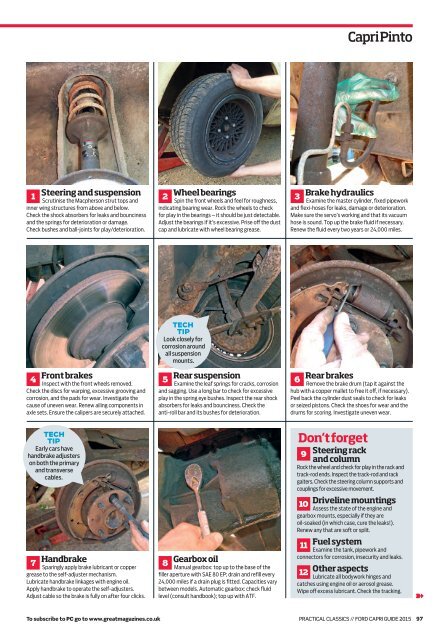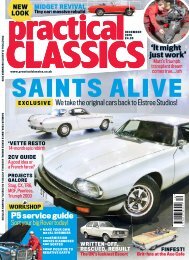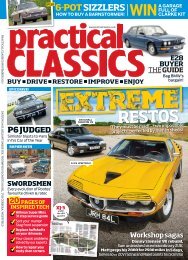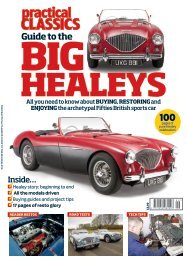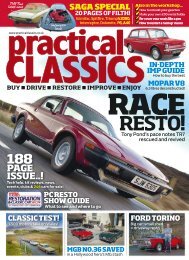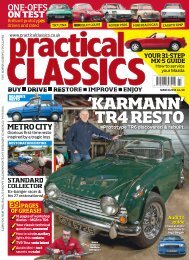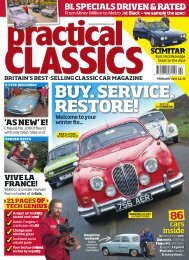You also want an ePaper? Increase the reach of your titles
YUMPU automatically turns print PDFs into web optimized ePapers that Google loves.
Capri Pinto<br />
1<br />
Steering and suspension<br />
Scrutinise the Macpherson strut tops and<br />
inner wing structures from above and below.<br />
Check the shock absorbers for leaks and bounciness<br />
and the springs for deterioration or damage.<br />
Check bushes and ball-joints for play/deterioration.<br />
2<br />
Wheel bearings<br />
Spin the front wheels and feel for roughness,<br />
indicating bearing wear. Rock the wheels to check<br />
for play in the bearings – it should be just detectable.<br />
Adjust the bearings if it’s excessive. Prise of the dust<br />
cap and lubricate with wheel bearing grease.<br />
3<br />
Brake hydraulics<br />
Examine the master cylinder, fixed pipework<br />
and flexi-hoses for leaks, damage or deterioration.<br />
Make sure the servo’s working and that its vacuum<br />
hose is sound. Top up the brake fluid if necessary.<br />
Renew the fluid every two years or 24,000 miles.<br />
TECH<br />
TIP<br />
Look closely for<br />
corrosion around<br />
all suspension<br />
mounts.<br />
4<br />
Front brakes<br />
Inspect with the front wheels removed.<br />
Check the discs for warping, excessive grooving and<br />
corrosion, and the pads for wear. Investigate the<br />
cause of uneven wear. Renew ailing components in<br />
axle sets. Ensure the calipers are securely attached.<br />
5<br />
Rear suspension<br />
Examine the leaf springs for cracks, corrosion<br />
and sagging. Use a long bar to check for excessive<br />
play in the spring eye bushes. Inspect the rear shock<br />
absorbers for leaks and bounciness. Check the<br />
anti-roll bar and its bushes for deterioration.<br />
6<br />
Rear brakes<br />
Remove the brake drum (tap it against the<br />
hub with a copper mallet to free it of, if necessary).<br />
Peel back the cylinder dust seals to check for leaks<br />
or seized pistons. Check the shoes for wear and the<br />
drums for scoring. Investigate uneven wear.<br />
TECH<br />
TIP<br />
Early cars have<br />
handbrake adjusters<br />
on both the primary<br />
and transverse<br />
cables.<br />
7 Handbrake<br />
Sparingly apply brake lubricant or copper<br />
grease to the self-adjuster mechanism.<br />
Lubricate handbrake linkages with engine oil.<br />
Apply handbrake to operate the self-adjusters.<br />
Adjust cable so the brake is fully on after four clicks.<br />
8<br />
Gearbox oil<br />
Manual gearbox: top up to the base of the<br />
filler aperture with SAE 80 EP; drain and refill every<br />
24,000 miles if a drain plug is fitted. Capacities vary<br />
between models. Automatic gearbox: check fluid<br />
level (consult handbook); top up with ATF.<br />
Don’t forget<br />
9<br />
Steering rack<br />
and column<br />
Rock the wheel and check for play in the rack and<br />
track-rod ends. Inspect the track-rod and rack<br />
gaiters. Check the steering column supports and<br />
couplings for excessive movement.<br />
10<br />
Driveline mountings<br />
Assess the state of the engine and<br />
gearbox mounts, especially if they are<br />
oil-soaked (in which case, cure the leaks!).<br />
Renew any that are soft or split.<br />
11<br />
Fuel system<br />
Examine the tank, pipework and<br />
connectors for corrosion, insecurity and leaks.<br />
12<br />
Other aspects<br />
Lubricate all bodywork hinges and<br />
catches using engine oil or aerosol grease.<br />
Wipe of excess lubricant. Check the tracking.<br />
➽<br />
To subscribe to PC go to www.greatmagazines.co.uk<br />
PRACTICAL CLASSICS // <strong>FORD</strong> <strong>CAPRI</strong> GUIDE 2015 97


